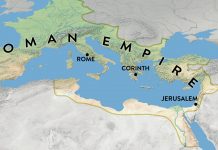The story of Jesus’s first coming to earth is remarkable, not only because it was foretold thousands of years in advance, but also because the prophesied details of His passion and death were exactly fulfilled.
The sacred writings of the Old Testament used several phrases to refer to the divine Saviour who was to come. Some of these have come to define the image of the Messiah: the Seed of the Woman, the Star out of Jacob, the Prophet, the ruler’s staff of Judah, the Son of David, the Anointed One (or Messiah), Immanuel, or the Servant of Yahweh.
For more than a millennium and a half, from the departure from Egypt and the founding of the Jewish nation to the birth of Jesus, the hopes of the Jewish people were anchored in the event of the coming of the Messiah. In the Jewish dream, the Messiah was imagined as a charismatic political leader, a relentless warrior, a brilliant king, and a faithful priest who would bring justice and reform. This Messiah was compared to the prophet Moses or the Maccabean warriors, whom He would surpass in deeds, power, and glory.
The expectations of the Jewish nation were not fulfilled by the Teacher of Nazareth. But the astonishment comes from the fact that the Jews did not understand what the inspired writers of the Old Testament had repeatedly foretold: that the Messiah would come to suffer, to be afflicted, and to die.
The chronicle of a foretold death
The Old Testament contains 22 references to the betrayal, trial, and crucifixion of Jesus. All these prophecies were fulfilled with astonishing accuracy in the space of just 24 hours. In describing the scene of the Last Supper, the Evangelist John shows Jesus identifying His betrayer by offering him a piece of bread (John 13:26). This was the fulfilment of a prophecy in Psalm 41:9: “Even my close friend, someone I trusted, one who shared my bread, has turned against me”.
Not only had the Old Testament writers prophesied the act of betrayal, they had even foretold the price for which Jesus would be sold to the priests. The prophet Zechariah wrote centuries before Judas Iscariot was born: “They paid me thirty pieces of silver” (Zechariah 11:12). The evangelist Matthew confirmed that the chief priests “counted out for him [Judas] thirty pieces of silver” (Matthew 26:15).
Probably the most impressive and complete prophetic portrait of the Messiah in the Old Testament is found in the 53rd chapter of Isaiah. The “Servant of the Lord” is described here with words such as “despised and rejected by mankind”, “man of suffering, and familiar with pain”, “pierced for our transgressions”, “crushed for our iniquities”. Every word written by Isaiah, eight centuries before Christ, accurately described aspects of the life of Jesus of Nazareth. “He was oppressed and afflicted, yet He did not open his mouth” writes Isaiah in verse 7. The evangelists confirm that Jesus was silent in the face of His accusers and judges.
When He carried His heavy cross on the Via Dolorosa, but also when He was on the cross, Jesus was the object of ridicule by the crowds. “Those who passed by hurled insults at Him, shaking their heads” (Matthew 27:39) in disapproval or contempt. This detail was also foretold: “I am an object of scorn to my accusers; when they see me, they shake their heads” (Psalm 109:25).
“They will look on me, the one they have pierced, and they will mourn for him as one mourns for an only child, and grieve bitterly for him as one grieves for a firstborn son” —these words, taken as if from the Gospel text, were actually written by the prophet Zechariah (12:10), long before they were fulfilled during the life of Christ. The crucifixion was seen with a prophetic eye by the prophet King David: “Dogs surround me, a pack of villains encircles me; they pierce my hands and my feet” (Psalm 22:16). The same Psalm also mentions the clothes of Christ, for which the Roman soldiers cast lots (Luke 23:34), according to the words of the prophecy in Psalm 22:18: “They divide my clothes among them and cast lots for my garment”.
Another Old Testament prophecy about the last days of Christ’s life concerns His tomb. “He was assigned a grave with the wicked, and with the rich in his death” wrote the prophet Isaiah (53:9). Eight centuries after this prophecy was written, a rich man, Joseph of Arimathea, asked Governor Pilate for permission to take the body of Jesus. “Then he took it down, wrapped it in linen cloth and placed it in a tomb cut in the rock, one in which no one had yet been laid” (Luke 23:53).
Probabilities and the certainty of a conclusion
The Jews were not prepared to meet a Messiah who was born in a manger, in a family of humble circumstances, and who would be the victim of suffering, beatings, insults, false accusations, and betrayal. Their disappointment was the result of a seductive but erroneous hermeneutical exercise. It is true that the authors of the Old Testament had also written of the glory of the Messiah and of a universal kingdom of peace and justice. But the road to that kingdom had to pass through the hill of Golgotha. Jesus’s contemporaries preferred to ignore the prophecies of Christ’s passion and death, focusing their attention on the details that suited their own desires.
But the prophecies about the Messiah confirm to the reader of the Bible, in every place and time, that Jesus is the one and only true Messiah. The fulfilment of prophetic details is beyond the control of mankind or nature. As for the claims of some sceptics, scholar Peter Stoner comments in Science Speaks: “If these estimates are considered fair, one man in how many men, the world over, will fulfil all eight prophecies? This question can be answered by applying our principles of probability. Written out this number is 1 in 10,000,000,000,000,000,000,000,000,000”[1].



















